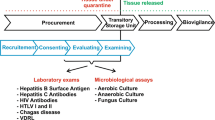Abstract
Human tissue is shipped to surgeons in the UK in either a freeze-dried or frozen state. To ensure quality and safety of the tissue, frozen tissue must be shipped in insulated containers such that tissue is maintained at an appropriate temperature. UK Blood Transfusion Service regulations state “Transportation systems must be validated to show maintenance of the required storage temperature” and also state that frozen, non-cryopreserved tissue “must be transported… at −20 °C or lower” (Guidelines for the Blood Transfusion Services in the United Kingdom, 8th Edn. 2013). To maintain an expiry date for frozen tissue longer than 6 months, the tissue must be maintained at a temperature of −40 °C or below. The objective of this study was to evaluate and validate the capability of a commercially available insulated polystyrene carton (XPL10), packed with dry ice, to maintain tissue temperature below −40 °C. Tissue temperature of a single frozen femoral head or a single frozen Achilles tendon, was recorded over a 4-day period at 37 °C, inside a XPL10 carton with dry ice as refrigerant. The data demonstrate that at 37 °C, the XPL10 carton with 9.5 kg of dry ice maintained femoral head and tendon tissue temperature below −55 °C for at least 48 h; tissue temperature did not rise above −40 °C until at least 70 h. Data also indicated that at a storage temperature lower than 37 °C, tissue temperature was maintained for longer periods.






Similar content being viewed by others
References
ASTM Standard D3103 (2007) Standard test method for thermal insulation performance of distribution packages
Choi SJ, Burgess G (2007) Practical mathematical model to predict the performance of insulating packages. Packag Technol Sci 20:369–380. www.coldchaintech.com/simple.php. Accessed 11/02/2013
Elliott MA, Halbert GW (2005) Maintaining the cold chain shipping environment for Phase 1 clinical trail distribution. Int J Pharm 299:49–54
Guidelines for the Blood Transfusion Services in the United Kingdom, Chapter 23, 8th Edn., updated 2013. The Stationary Office, London. www.transfusionguidelines.org.uk/Index.aspx?Publication=RB&Section=25&pageid=700 accessed 08/02/2013
Miller TD, Maxwell AJ, Lindquirst TD, Requard J (2013) Validation of cooling effect of insulated containers for the shipment of corneal tissue and recommendation for transport. Cornea 32:63–69
Ohkawara H, Kitagawa T, Fukushima N, Ito T, Sawa Y, Yoshimine T (2012) A newly developed container for safe, easy and cost effective overnight transportation of tissues and organs by electrically keeping tissue of organ temperature at 3 to 6 °C. Transplant Proc 44:855–858
Rentas FJ, MacDonald VW, Houchens DM, Hmel PJ, Reid TJ (2004) New insulation technology provides next-generation containers for “iceless” and lightweight transport of RBCs at 1 to 10 °C in extreme temperatures for over 78 hours. Transfusion 44:210–216
Singh SP, Burgess G, Singh J (2008) Performance comparison of thermal insulated packaging boxes and refrigerants for single-parcel shipments. Packag Technol Sci 21:25–35
Acknowledgments
We acknowledge support of this work from the NHSBT.
Author information
Authors and Affiliations
Corresponding author
Rights and permissions
About this article
Cite this article
Rooney, P., Eagle, M.J. & Kearney, J.N. Validation of cold chain shipping environment for transport of allografts as part of a human tissue bank returns policy. Cell Tissue Bank 16, 553–558 (2015). https://doi.org/10.1007/s10561-015-9502-0
Received:
Accepted:
Published:
Issue Date:
DOI: https://doi.org/10.1007/s10561-015-9502-0



